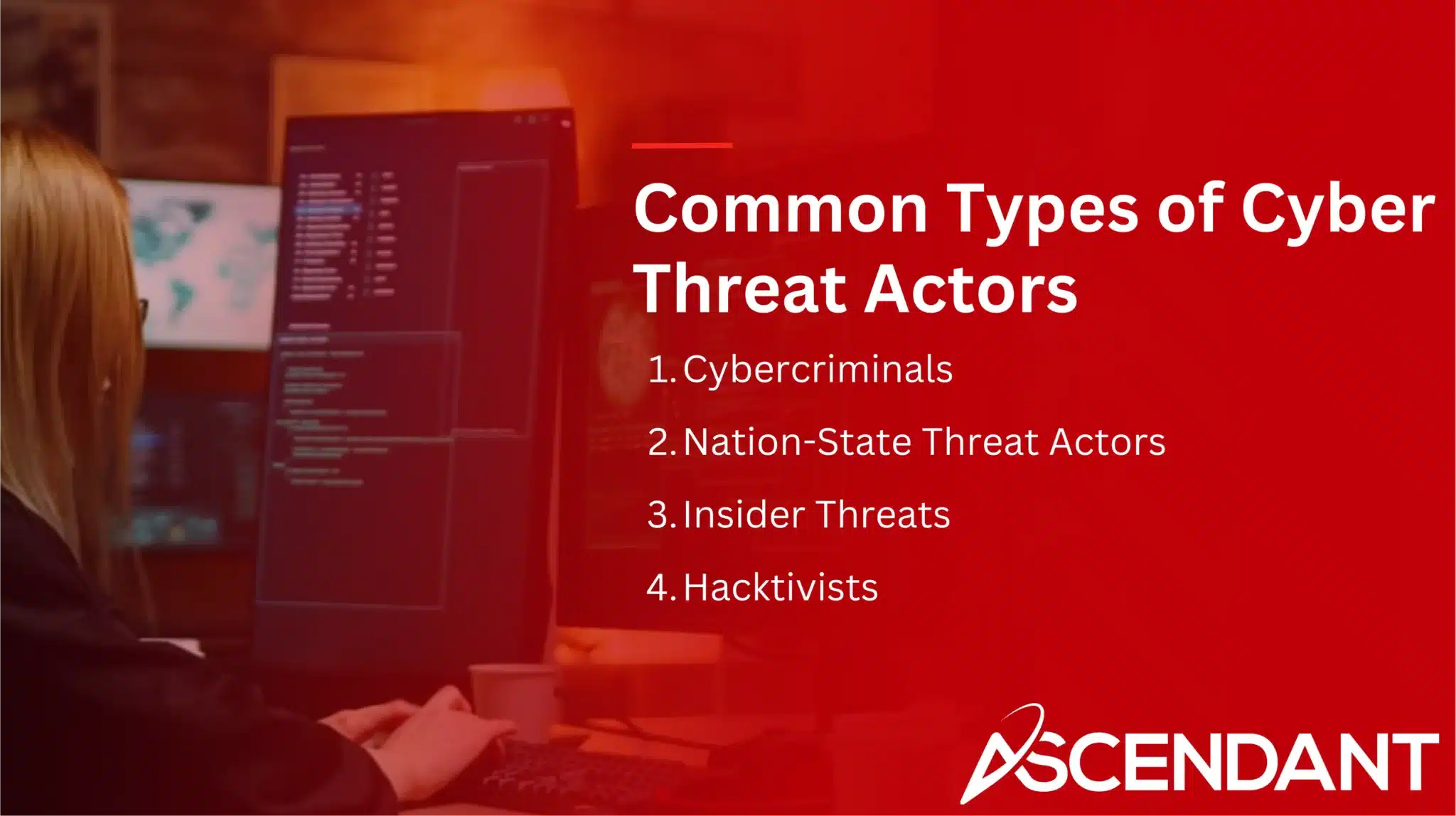A threat actor is an individual or group that engages in malicious activities targeting digital systems. These actors exploit vulnerabilities to steal data, disrupt operations, or cause harm. They can range from lone hackers to organized groups and even nation-states. Understanding threat actors is crucial in defending against cyber attacks and protecting sensitive information.
In This Article:
- Defining a Cyber Threat Actor
- Key Motivations Behind Cyber Threat Actors
- Common Types of Cyber Threat Actors
- Tools and Tactics Used by Threat Actors
- Threat Intelligence and Proactive Defense
- Real-World Examples of Cyber Threat Actors
- Effective Strategies to Mitigate Threat Actor Risks
Key Takeaways
- Cyber threat actors range from individual hackers to organized crime and nation-state groups, each targeting digital vulnerabilities for malicious purposes.
- Motivations for cyber attacks include financial gain, political objectives, personal grievances, and social activism, influencing the tactics employed by different threat actors.
- Effective cybersecurity strategies involve understanding threat actors, utilizing threat intelligence, implementing proactive defenses like multi-factor authentication, and adopting a zero trust security model.
Defining a Cyber Threat Actor
Individuals or collectives engaging in cyber-attacks are referred to as cyber threat actors. These can vary from solo operators to well-organized syndicates, and may even involve nation states that seek out system vulnerabilities for exploitation through their malicious activities. While it’s recognized that not every hacker harbors harmful intentions, these particular individuals focus on inflicting damage or purloining sensitive information. They conduct broad assaults against various victims such as private citizens, enterprises, and governmental agencies by seeking out exploitable security gaps.
In the realm of cybersecurity, these nefarious figures significantly influence the frequency and severity of breaches by launching concerted attacks aimed at digital infrastructures. Their favorite prizes often include trade secrets, critical corporate data, and other classified materials. By gaining an insight into the identity of these perpetrators along with their methods of operation, we have a greater advantage when it comes to fortifying defenses against future incursions they might attempt.
Key Motivations Behind Cyber Threat Actors
Individuals or groups that pose a cyber threat, known as threat actors, have various motives ranging from the pursuit of financial gain to advancing political or social agendas. Those seeking monetary rewards are often involved in unlawful activities such as data theft, orchestrating ransomware campaigns, and initiating phishing schemes with the aim of profiting financially. Conversely, nation-state threat actors are Motivated by strategic geopolitical interests which may include conducting cyber espionage operations and targeting critical infrastructure to cause disruption.
On another front stand hacktivists who carry out their actions fueled by political or social causes—championing issues like freedom of expression and human rights protection. There are those whose motivations stem from individual disputes. These attackers might engage in malicious online behavior for reasons linked to personal retribution or self-gratification. Comprehending the diverse incentives behind these hostile entities is crucial for crafting precise countermeasures to stop them and diminish the threats they present.
Common Types of Cyber Threat Actors
The cyber threat landscape is populated by various types of threat actors, including cybercriminals, nation-state actors, insider threats, and hacktivists. Most threat actors have unique characteristics, motivations, and methods of attack, which we will explore in detail.
Cybercriminals
Cybercriminals, who may operate individually or as part of organized syndicates, engage in illicit online operations with the primary objective of monetary gain. They employ various strategies including initiating phishing expeditions, employing ransomware to lock data and extort payments, as well as implanting banking Trojans to commandeer funds or personal credentials. These adversaries commonly prey on companies that exhibit insufficient security measures in an effort to capitalize on vulnerabilities for their own financial benefit.
Due to its low overhead and substantial potential profits, phishing is a particularly appealing method for these criminals. Their activities encompass actions such as appropriating sensitive information from unsuspecting victims by deceptive means, which often culminates in the acquisition of stolen data through coerced monetary transactions and extortionate demands.
To effectively combat these threats and fortify cyber defenses against them, requires a thorough comprehension of their tactics utilized by these digital felons.
Nation-State Threat Actors
Nation-state threat actors are driven by the goal of gaining strategic advantages and supporting their national interests. These actors often receive backing from their respective governments, which enables them to carry out complex cyber espionage and warfare activities, as well as to disrupt critical infrastructure systems. As part of this group, Advanced Persistent Threat (APT) collectives focus on extensive intelligence operations and sustained espionage efforts that qualify as advanced persistent threats.
Such state sponsored threat actors mainly aim their sights at government institutions, vital infrastructure entities, and major corporations, including those associated with organized crime groups. The targets chosen by these threat actors typically require sophisticated approaches due to high levels of security. Hence they are incredibly tenacious and challenging when it comes to detection.
A notable instance is Aoqin Dragon—a particular actor engaging in the collection of sensitive data primarily within sectors like telecommunications and governmental spheres for purposes aligned with espionage.
Insider Threats
Insider threats stem from within the company, typically involving workers or contractors who have legitimate access rights. Motivated by personal issues or monetary gain, these individuals can exploit their access for improper purposes. Insider threats account for nearly 30% of all data breaches and are especially difficult to identify and mitigate due to their authorized status coupled with malicious intent.
Hacktivists
Individuals or collectives known as hacktivists act driven by political or social convictions, aiming to challenge injustices they identify. Unlike those motivated by profit, their main objective is not financial gain but rather the advancement of their political ideologies. They frequently engage in tactics such as DDoS attacks and data theft with the intention of uncovering damaging information that can lead to public disgrace.
Entities like ‘Anonymous’ stand out among hacktivist groups for taking on targets that conflict ideologically with them, making a name for themselves through such confrontations.
Tools and Tactics Used by Threat Actors
To accomplish their nefarious goals, threat actors utilize an arsenal of methods, such as malware and ransomware attacks, alongside phishing scams and DDoS (Distributed Denial of Service) assaults. Recognizing these strategies is vital to devise robust protective measures and counteractions.
Phishing Attacks
Malicious activities like phishing attacks employ cunning emails and counterfeit websites to coax sensitive information from unsuspecting individuals. These clever schemes typically disguise themselves as trustworthy sources, posing a challenge for detection. They aim to pilfer data including login credentials that might be exploited for illegitimate access or additional nefarious acts.
Malware
Malware, or malicious software, is designed to damage or disable computer systems and steal data. Common types include viruses, worms, Trojans, and ransomware. Ransomware specifically encrypts files or locks systems, demanding payment for decryption. Drive-by downloads can install malware when users visit compromised websites.
Malware can spread through various means. This includes email attachments, infected websites, and compromised software. Ransomware actors often use email attachments and compromised websites to distribute their malware. They may also engage in data extortion, threatening to publish sensitive documents if the ransom is not paid.
DDoS Attacks
Distributed Denial-of-Service (DDoS) attacks are designed to render online services inoperable by inundating them with an overwhelming amount of traffic. This can be achieved by bombarding the target with a flood of excessive requests, compromising data integrity, or exploiting weaknesses that strain system resources.
Threat Intelligence and Proactive Defense
Proactive defense and threat intelligence play a pivotal role in outpacing cyber threats. It is vital to comprehend the tactics, techniques, and procedures (TTPs) used by threat actors for formulating robust cybersecurity measures. By taking proactive steps, one can detect and neutralize potential threats before they inflict serious damage.
Threat Hunting
Proactive identification of network vulnerabilities and potential threats is at the core of threat hunting. This process entails a meticulous methodology that involves setting off alerts, scrutinizing questionable activities, and neutralizing detected threats. Analyzing data for irregular patterns plays a crucial role in effective threat hunting as it helps in recognizing signs of an actual or forthcoming breach.
Enhancing real-time detection capabilities can be achieved by combining endpoint detection and response solutions with active pursuit strategies for identifying unauthorized network intrusions. Incorporating third-party services dedicated to evaluating the reputation of various cyber threats substantially augments an organization’s capacity to recognize and counteract new emerging cyber threats.
Multi-Factor Authentication
Incorporating multi-factor authentication (MFA) into a cybersecurity strategy markedly diminishes the likelihood of unauthorized access, as it requires various methods of verification. This bolstered security measure ensures protection even in instances where passwords may be compromised, establishing MFA as an essential component for safeguarding information.
Real-World Examples of Cyber Threat Actors
Incidents like the SolarWinds hack and North Korean ransomware operations underscore the influence of cyber threat actors. These events have heightened cybersecurity awareness and spurred enhancements in both threat intelligence gathering and international collaboration to combat cyber threats.
REvil Ransomware
Known for its attacks on businesses and the demand of hefty ransoms to unlock encrypted data, the REvil ransomware group launched a prominent attack on Kaseya VSA servers by exploiting software vulnerabilities. This incident affected many clients and led to REvil demanding a $50 million ransom in exchange for a universal decryption tool that would restore access to the compromised data.
Aoqin Dragon
The Aoqin Dragon is a cyber threat actor group that receives nation-state support, mainly aiming its attacks at the government, education, and telecommunications sectors within Southeast Asia and Australia. The group’s central objective is to conduct espionage activities by collecting sensitive information that could yield strategic benefits.
Effective Strategies to Mitigate Threat Actor Risks
A robust cybersecurity strategy must integrate threat intelligence, proactive defense measures, and constant surveillance to reduce the risk of threat actors. It is also crucial to carry out frequent risk evaluations and ensure that employees undergo continuous training.
Endpoint Protection, Detection, and Response (EDR)
Defending network endpoints against malware and a range of other threats is what endpoint protection entails. EDR (Endpoint Detection and Response) solutions are designed to detect unusual activities, generate alerts, document behaviors at the endpoint, prevent harmful actions, and propose measures for remediation.
Zero Trust Security
To safeguard against unauthorized access and mitigate the risk of insider threats, the zero trust security model insists on incessant validation for every interaction involving users and devices. It operates under the assumption that all interactions could be malevolent until they are authenticated, thereby aiding in the prevention of data breaches.
Enhancing Threat Intelligence
Advancing threat intelligence demands the deployment of cutting-edge technologies and harnessing real-time data to predict and counter imminent cyber threats. Cross-border collaboration between entities bolsters the exchange of threat intelligence, thus fortifying global cybersecurity.
Working together in this manner amplifies our ability to tackle cyber threats with greater efficiency and secures a strategic advantage in doing so.
Summary
In summary, understanding the various types of cyber threat actors, their motivations, and tactics is crucial for developing effective cybersecurity strategies. By staying informed and implementing proactive defense measures, organizations can better protect themselves against the ever-evolving cyber threat landscape.
 Frequently Asked Questions
Frequently Asked Questions
What are the main motivations behind cyber threat actors?
Cyber threat actors are primarily motivated by financial gain, political or social objectives, and personal grievances. Understanding these motivations is crucial for developing effective cybersecurity strategies.
How do cybercriminals typically operate?
Cybercriminals typically operate by employing tactics such as phishing, ransomware attacks, and data theft to achieve financial gain. Their methods often exploit human vulnerability and technological weaknesses.
What is the role of nation-state threat actors?
Primarily targeting governmental institutions and critical infrastructure, nation-state threat actors are involved in cyber espionage and warfare to compromise national security and secure strategic benefits.
Why are insider threats challenging to detect?
Due to the inherent trust and authorized access that individuals within an organization possess, it becomes difficult to identify insider threats as they can exploit their privileges subtly without immediate detection.
Insiders have a deep understanding of the internal systems of their organizations, which enables them to circumvent standard security protocols with ease.
How can organizations enhance their threat intelligence?
Organizations can enhance their threat intelligence by leveraging advanced technologies and real-time data, while also fostering international cooperation for information sharing.
This multifaceted approach ensures a proactive stance against emerging threats.


